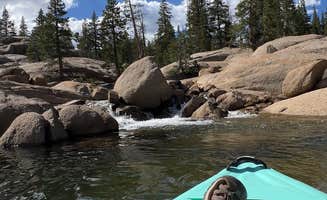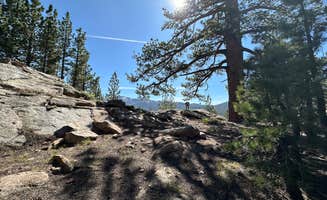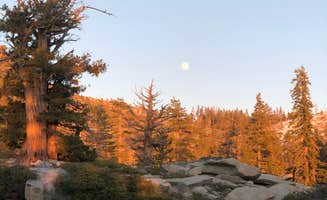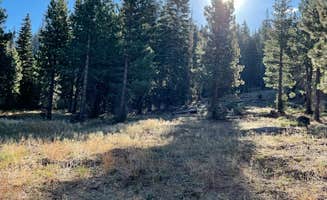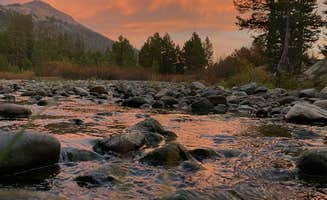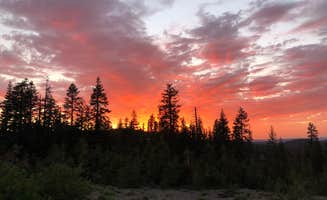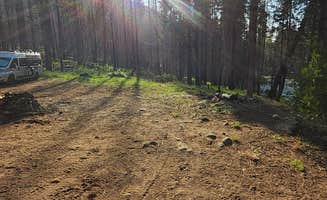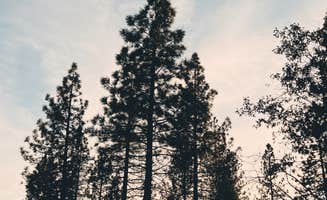Primitive camping near Markleeville, California offers self-reliant outdoor experiences across national forest lands at elevations ranging from 5,500 to 8,300 feet. Most dispersed sites lack formal amenities and operate under strict fire restrictions that vary throughout the year. Summer temperatures typically range from 45-85°F with afternoon thunderstorms common in July and August.
What to do
Watercraft activities: Blue Lakes Road provides access to lakes where visitors can enjoy kayaking and boating. According to one camper at Dispersed USFS, "The Blue Lakes are just down the road for swimming, boating, kayaking etc and lots of amazing 4x4 trails. Rivers for fishing and endless hiking and biking."
Mountain biking: Numerous trails around Bear Valley offer options for cycling enthusiasts. A visitor at Bear Valley Dispersed Camping mentioned, "Location was near trails to rock climbing, mountain biking, hiking."
Stargazing opportunities: Clear mountain air and minimal light pollution create excellent night sky viewing. One camper at Bear Valley Dispersed Camping noted, "Perfect spot for star gazing!! We arrived when it was dark and had no problem finding a spot! It was open with plenty of spots & we were the only ones!"
OHV trail access: Several areas connect to off-highway vehicle routes. A reviewer at Iron MT. Dispersed mentioned, "There are also many OHV trails close by."
What campers like
Stunning sunsets: Many campers noted remarkable evening views across the region. At Iron MT. Dispersed, one visitor reported, "The sun set are awesome can see colors in the sky for a good two hour."
Ease of access for overnight stays: Some areas provide convenient quick-stop options. A camper at Scotts Lake Rd Dispersed Camping noted, "Easy to see right off the road with plenty of campsites down either side of a nice dirt road."
Wildlife viewing: The area supports diverse mountain wildlife populations. At Scotts Lake Rd Dispersed Camping, a visitor observed, "There are herds of cows that will make their way through the area, please be respectful of them!"
Privacy options: Many locations offer secluded camping spots away from crowds. A camper at USFS Silver Fork Dispersed shared, "I stayed here for 7 days (10/31-11/6) and only saw one other person on the primitive roads."
What you should know
Road conditions vary dramatically: Many access roads require specialized vehicles. A reviewer at Dispersed USFS warned, "There are prolonged climbs to get here (up to about 8% grade) but my bus did fine. Slow and steady and you'll be fine. Also WATCH THE WEATHER! Rain can cause spots of the road in to get washed out a bit and deep puddles can appear."
Permit requirements: Some areas require advance documentation. At USFS Silver Fork Dispersed, a camper noted, "You are required to have a permit for any day/overnight use in Eldorado, including this area. They can be easily acquired at recreation.gov."
Limited facilities: Most areas lack basic amenities. At Scotts Lake Rd Dispersed Camping, a visitor mentioned, "It is a great site just near the road. We arrived on Monday afternoon and there were lots of places. There were other people but everyone has enough space. There's a pit restroom which seems comparatively new."
Bug activity: Insects can be problematic during warmer months. One camper at Scotts Lake Rd Dispersed Camping reported, "Lots and lots of bugs. I sleep in my car and crack the windows a little bit and i woke up to a shit ton of bugs that got in my car. even more surrounding the cars."
Tips for camping with families
Proximity to supplies: Choose sites with nearby access to necessities. A visitor at USFS Silver Fork Dispersed recommended, "A huge plus is the gas station just about 5 minutes down the road. It's well-stocked with all the convenient store items you might have forgotten at home, making it easy to grab any last-minute necessities."
Fire safety precautions: Fire rules vary by season and location. At USFS Silver Fork Dispersed, one camper shared, "Caldor Fire damage was evident everywhere, but this made it easy for my son to chop down a small dead tree that we used for firewood."
Consider pit toilets: For families with younger children, seek out the few areas with basic facilities. A visitor at Packsaddle Pass - El Dorado National Forest Dispersed noted, "Standard dispersed camping on national forest land. Paved main road with dirt roads and areas for camping branching off."
Tips from RVers
Length limitations: Not all roads accommodate larger vehicles. At Silver Fork Dispersed, a camper warned about a nearby area, "The road towards the cabins has a very tight turn that will not allow anyone over 25 feet- though I'd recommend smaller."
Higher elevation spots for connectivity: Some locations offer better technical access. At Silver Fork Dispersed, one visitor noted, "This location was the site of a fire several years ago, this means that many of the trees have been cleared making it a good site for starlink users like me."
Spacious areas for larger rigs: Some dispersed areas accommodate substantial RVs. A visitor at Scotts Lake Rd Dispersed Camping shared, "We are new to dispersed camping and have a 40 ft 5th wheel as well as a GMC Denali 350 dually. We need a large space to fit into. We arrived on a Monday at noon and found that the large area about 1/4 mile in was not at all crowded."


